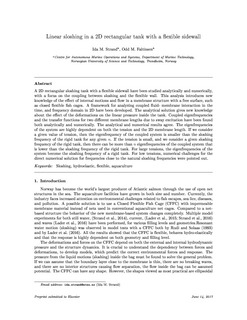Linear sloshing in a 2D rectangular tank with a flexible sidewall
Journal article
Submitted version
Permanent lenke
http://hdl.handle.net/11250/2460369Utgivelsesdato
2017Metadata
Vis full innførselSamlinger
- Institutt for marin teknikk [3472]
- Publikasjoner fra CRIStin - NTNU [38576]
Originalversjon
Journal of Fluids and Structures. 2017, 73 70-81. 10.1016/j.jfluidstructs.2017.06.005Sammendrag
A 2D rectangular sloshing tank with a flexible sidewall have been studied analytically and numerically, with a focus on the coupling between sloshing and the flexible wall. This analysis introduces new knowledge of the effect of internal motions and flow in a membrane structure with a free surface, such as closed flexible fish cages. A framework for analyzing coupled fluid–membrane interaction in the time, and frequency domain in 2D have been developed. The analytical solution gives new knowledge about the effect of the deformations on the linear pressure inside the tank. Coupled eigenfrequencies and the transfer functions for two different membrane lengths due to sway excitation have been found both analytically and numerically. The analytical and numerical results agree. The eigenfrequencies of the system are highly dependent on both the tension and the 2D membrane length. If we consider a given value of tension, then the eigenfrequency of the coupled system is smaller than the sloshing frequency of the rigid tank for any given n. If the tension is small, and we consider a given sloshing frequency of the rigid tank, then there can be more than n eigenfrequencies of the coupled system that is lower than the sloshing frequency of the rigid tank. For large tensions, the eigenfrequencies of the system become the sloshing frequency of a rigid tank. For low tensions, numerical challenges for the direct numerical solution for frequencies close to the natural sloshing frequencies were pointed out.
